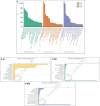Whole genome analysis of endophytic strain PM1 reveals promising plant Growth-Promoting mechanisms in pomegranate
- PMID: 40390499
- PMCID: PMC12002771
- DOI: 10.1016/j.jgeb.2025.100486
Whole genome analysis of endophytic strain PM1 reveals promising plant Growth-Promoting mechanisms in pomegranate
Abstract
The plant ecosystem harbours diverse symbiotic microorganisms with plant growth promoting and biocontrol activities. The gram- negative endophytic bacterium PM1 strain, isolated from the nodal region of pomegranate. The strain PM1 was studied through whole-genome sequencing, functional annotation, and plant growth-promoting trait (PGPT) gene analysis. Phylogenetic tree analysis and 16S rDNA sequencing confirmed its classification within the genus Brucella. The assembled genome size was 5,200,895 bp with a G + C content of 56.4 %. The average nucleotide identity (ANI) analysis revealed a 97.62 % similarity between PM1 and B. anthropi ATCC 49188 T, a type strain derived from human clinical samples, indicating a close relationship with Brucella anthropi. The functional annotation revealed 2,945 PGPT-related genes, including 32 % linked to direct effects (phytohormone signal production, biofertilization, and bioremediation processes) and 67 % to indirect effects (plant colonization, biocontrol, and competitive exclusion). KEGG analysis revealed genes involved in nitrogen metabolism, phosphate solubilization, siderophore production, hormone biosynthesis (gibberellin, cytokinin, and auxin), root colonization, and stress mitigation. Virulence factor database (VFDB) data revealed the absence of complete virulence gene assemblies, indicating limited pathogenic potential. Furthermore, secondary metabolite analysis predicted the potential production of ochrobactin compounds, which are potent siderophores that are important traits associated with PGPTs. The complete genome analysis of Brucella sp. PM1 provides new insights into plant-bacteria interactions, laying a foundation for advanced postgenomic studies and facilitating the development of bioeffective strategies such as biofertilizers or biocontrol agents for sustainable improvement in crop yields.
Keywords: Brucella anthropi; Endophyte; Plant growth promoting traits (PGPTs); Pomegranate; Secondary metabolites.
Copyright © 2025. Published by Elsevier Inc.
Conflict of interest statement
Declaration of competing interest The authors declare that they have no known competing financial interests or personal relationships that could have appeared to influence the work reported in this paper.
Figures









Similar articles
-
Molecular characterization of an endophytic strain of Bacillus subtilis with plant growth-promoting properties from a wild relative of papaya.J Appl Microbiol. 2025 Jan 6;136(1):lxaf010. doi: 10.1093/jambio/lxaf010. J Appl Microbiol. 2025. PMID: 39777499
-
Deciphering the potential of a plant growth promoting endophyte Rhizobium sp. WYJ-E13, and functional annotation of the genes involved in the metabolic pathway.Front Microbiol. 2022 Nov 3;13:1035167. doi: 10.3389/fmicb.2022.1035167. eCollection 2022. Front Microbiol. 2022. PMID: 36406393 Free PMC article.
-
Genomic Characteristics and Functional Analysis of Brucella sp. Strain WY7 Isolated from Antarctic Krill.Microorganisms. 2023 Sep 11;11(9):2281. doi: 10.3390/microorganisms11092281. Microorganisms. 2023. PMID: 37764125 Free PMC article.
-
The Endophytic Microbiome as a Hotspot of Synergistic Interactions, with Prospects of Plant Growth Promotion.Biology (Basel). 2021 Feb 1;10(2):101. doi: 10.3390/biology10020101. Biology (Basel). 2021. PMID: 33535706 Free PMC article. Review.
-
Endophytic Actinobacteria and the Interaction of Micromonospora and Nitrogen Fixing Plants.Front Microbiol. 2015 Dec 1;6:1341. doi: 10.3389/fmicb.2015.01341. eCollection 2015. Front Microbiol. 2015. PMID: 26648923 Free PMC article. Review.
References
-
- Zeynalova A.M., Origin N.EN. taxonomy and systematics of pomegranate. Proc Inst Bot Azerbaijan Natl Acad Sci. 2017;37
-
- Desai P., Patil G., Dholiya B., Desai S., Patel F., Narayanan S. Development of an efficient micropropagation protocol through axillary shoot proliferation for pomegranate variety ‘Bhagwa.’. Ann Agrar Sci. 2018;16:444–450.
-
- Karn M., Sharma S.K., Sharma A., Pal J. Isolation and characterization of endophytes against bacterial blight of pomegranate. Int J Bio-Resource Stress Manag. 2022;13:683–692.
LinkOut - more resources
Full Text Sources
